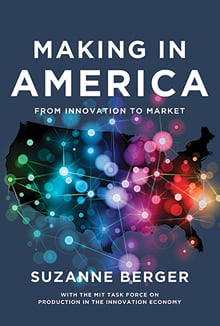You’d be hard-pressed to find many items with a “Made in U.S.A.” sticker in a typical big-box retail store. But can’t the United States rely on countries like China to inexpensively manufacture the products we buy?

By Suzanne Berger with the PIE Task Force
MIT Press, 2013, $24.95
In her latest book, Making in America: From Innovation to Market, political science professor Suzanne Berger examines this question in depth and comes out firmly in support of domestic production. She argues that manufacturing is critical to accelerating innovation, which fuels economic growth.
Berger wrote the book with MIT’s Task Force on Production in the Innovation Economy (PIE), a commission she cochairs that was created in 2010 after nearly two million manufacturing jobs were lost in two years during the recession. In interviews with about 250 companies ranging from General Electric to tiny startups, PIE researchers hammered on a few basic questions: If you have a new product idea, where should you locate manufacturing? What needs to be nearby and what could be anywhere in the world?
The answer became clear when Berger visited Tonio Buonassisi’s lab at MIT. Many of his innovations involve the equipment used to make elements of photovoltaic cells. Interacting face-to-face with those who make and operate that equipment gives him ideas on how to lower the cost of solar power. “In many ways we saw similar things across the country,” Berger says. When new technologies are being commercialized, having R&D and manufacturing in close proximity can help engineers optimize product design and production.
Manufacturers can also help accelerate economic growth by repurposing existing equipment for use in new areas. A metalworking shop in Ohio, for instance, supplied metal plates to protect military Humvees but saw an opportunity to use the same techniques to make lighter and more fuel-efficient aircraft carrier parts.
But manufacturers and suppliers are smaller today, creating what Berger calls “holes” in the industrial ecosystem. There are fewer resources to fund research, train workers, and scale up new ideas to commercialization. To combat this, she says, the government should help convene industry associations, funded with private and public money, that provide companies with shared resources, such as access to new technologies and worker training. A good example is the National Additive Manufacturing Innovation Institute (NAMII) in Youngstown, Ohio, a consortium of companies, research universities, community colleges, and economic development groups that organized to compete for federal seed funding.
Berger is optimistic about the future. The United States has cheap natural gas, wages are rising in China, and companies now better understand the hidden costs of outsourcing. New technologies, such as robotics and 3-D printing, can make manufacturers more productive, too. Apple has had great success designing products in California and manufacturing the bulk of them in China. But it’s not the only model for economic growth: some industries benefit from a much closer link between production and innovation.
Recent Books from the MIT community
Flourishing: A Frank Conversation about Sustainability
By John Ehrenfeld ’53, ScD ’57, and Andrew Hoffman, SM ’91, PhD ’95, Stanford University Press, 2013, $17.95
Purging the Poorest: Public Housing and the Design Politics of Twice-Cleared Communities
By Lawrence J. Vale, SM ’88, professor of urban studies and planning, University of Chicago Press, 2013, $27.50
No Better Time: The Brief, Remarkable Life of Danny Lewin, the Genius Who Transformed the Internet
By Molly Knight Raskin, De Capo Press, 2013, $25.99
Periodic Operation of Reactors
By Peter L. Silveston ’51, SM ’53, and Robert R. Hudgins, Butterworth-Heinemann, 2013, $150
Introduction to Computation and Programing Using Python
By John V. Guttag, professor of computer science and engineering, MIT Press, 2013, $25
Inherited Responsibility and Historical Reconciliation in East Asia
Edited by Melissa Nobles, professor of political science, and Jun-Hyeok Kwak, Routledge, 2013, $135
Interpolation and Sidon Sets for Compact Groups
By Colin C. Graham, PhD ’68, and Kathryn E. Hare, Springer, 2013, $129
Fort Canning Hill: Exploring Singapore’s Heritage and Nature
By Melissa Lakich Diagana, SM ’87, and Jyoti Angresh, ORO Editions, 2013, $40
Please submit titles of books and papers published in 2013 and 2014 to be considered for this column.
Contact MIT News
E-mail mitnews@technologyreview.com
Write MIT News, One Main Street, 13th Floor, Cambridge, MA 02142
Fax 617-475-8043
Keep Reading
Most Popular
Large language models can do jaw-dropping things. But nobody knows exactly why.
And that's a problem. Figuring it out is one of the biggest scientific puzzles of our time and a crucial step towards controlling more powerful future models.
How scientists traced a mysterious covid case back to six toilets
When wastewater surveillance turns into a hunt for a single infected individual, the ethics get tricky.
The problem with plug-in hybrids? Their drivers.
Plug-in hybrids are often sold as a transition to EVs, but new data from Europe shows we’re still underestimating the emissions they produce.
Stay connected
Get the latest updates from
MIT Technology Review
Discover special offers, top stories, upcoming events, and more.